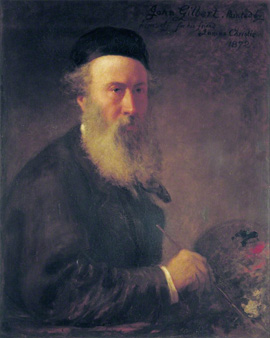The time when Queen Victoria ruled England is called the Victorian Age. It is considered to be an age of advancing industrialisation and technology conquered manufacturing. A disenchantment of the world accompanies the development. Artists form an antipole in time. It is the time to turn fairy tales into pictures and to allow dreams to come true. One of the most productive artists was Sir John Gilbert. In autodidactic teaching he acquired various means of representation. He drew, made illustrations and gained first attention in the British art scene. He did magic with watercolours and mastered the water in pigments like hardly any other British artist.
Letterpress printing was subject to industrial influence. John Gilbert felt at home here. He gave a visual language to the stories of Robin Hood. Shakespeare's world was given faces. And Gilbert created settings for the stories of Charles Dickens. Gilbert was very fortunate in creating wood engravings and watercolours. A feeling that was clearly expressed in his works. The artist John Gilbert had the honour to exhibit in the great schools of London. A novelty, as he himself could not show an academic career and the London art scene was an elitist circle. Gilbert's paintings are capable of telling stories. They are powerful and to a particularly high degree illustrative. Gilbert escapes reality and takes his viewers with him. A talent that was especially in demand in the Victorian age. Powerful yet with sensitive sensitivity, Gilbert created illustrations for stories and numerous children's books.
His talent and life for the arts elevated Sir John Gilbert to the position of President of the Royal Watercolour Society. The Academy sought to achieve greater recognition of watercolour painting in the arts. The often spherical watercolours had a difficult position compared to oil painting. Gilbert had dealt with both techniques and offered the advantages of watercolour painting. John Gilbert was awarded an academic degree based on his knowledge. Despite Gilbert's reputation in the days of Queen Victoria, his fame could not be carried over into modern times. Sir John Gilbert stands in the shadow of painters like Leighton, Watts or John Everett Millais. The artists are united by the fact that in a time when factory chimneys drew a dark world, they created a world in which people found refuge. The society withdrew and enjoyed a world with fairies and nature spirits. While at the same time in France, French painters captured the changes brought about by industry and greeted them cheerfully, the English retreated to romantic worlds and fairytale images.
×





.jpg)
.jpg)
.jpg)
.jpg)
.jpg)
.jpg)
.jpg)
.jpg)
.jpg)
.jpg)
.jpg)
.jpg)
.jpg)
.jpg)
.jpg)
.jpg)
.jpg)
.jpg)
.jpg)
.jpg)
.jpg)
.jpg)
.jpg)
.jpg)
.jpg)
.jpg)
.jpg)
.jpg)
.jpg)
.jpg)
_knighting_Francis_Drake_(1540-96)_from_Illustratio_-_(MeisterDrucke-89326).jpg)
_knighting_Francis_Drake_(1540-96)_from_Illustratio_-_(MeisterDrucke-89326).jpg)
.jpg)
.jpg)
 - (MeisterDrucke-149456).jpg)
 - (MeisterDrucke-149456).jpg)
.jpg)
.jpg)
.jpg)
.jpg)
.jpg)
.jpg)
.jpg)
.jpg)
 - (MeisterDrucke-176354).jpg)
 - (MeisterDrucke-176354).jpg)
.jpg)
.jpg)
.jpg)
.jpg)
.jpg)
.jpg)
.jpg)
.jpg)
.jpg)
.jpg)
.jpg)
.jpg)
.jpg)
.jpg)
.jpg)
.jpg)
.jpg)
.jpg)
.jpg)
.jpg)
.jpg)
.jpg)
.jpg)
.jpg)
.jpg)
.jpg)
.jpg)
.jpg)
.jpg)
.jpg)
.jpg)
.jpg)
.jpg)
.jpg)
.jpg)
.jpg)
.jpg)
.jpg)
.jpg)
.jpg)
.jpg)
.jpg)
.jpg)
.jpg)
.jpg)
.jpg)
.jpg)
.jpg)
.jpg)
.jpg)
.jpg)
.jpg)
.jpg)
.jpg)
.jpg)
.jpg)
.jpg)
.jpg)
.jpg)
.jpg)
.jpg)
.jpg)
.jpg)
.jpg)
.jpg)
.jpg)
.jpg)
.jpg)
_-_(MeisterDrucke-993051).jpg)
_-_(MeisterDrucke-993051).jpg)
.jpg)
.jpg)
.jpg)
.jpg)
.jpg)
.jpg)
.jpg)
.jpg)
.jpg)
.jpg)
.jpg)
.jpg)
.jpg)
.jpg)
.jpg)
.jpg)
.jpg)
.jpg)
.jpg)
.jpg)
.jpg)
.jpg)
.jpg)
.jpg)
.jpg)
.jpg)
.jpg)
.jpg)
.jpg)
.jpg)
.jpg)
.jpg)
.jpg)
.jpg)
.jpg)
.jpg)
.jpg)
.jpg)
.jpg)
.jpg)
.jpg)
.jpg)
.jpg)
.jpg)
.jpg)
.jpg)
.jpg)
.jpg)
.jpg)
.jpg)
.jpg)
.jpg)
.jpg)
.jpg)
_-_(MeisterDrucke-975728).jpg)
_-_(MeisterDrucke-975728).jpg)
 - (MeisterDrucke-37880).jpg)
 - (MeisterDrucke-37880).jpg)
_c1845_-_(MeisterDrucke-310323).jpg)
_c1845_-_(MeisterDrucke-310323).jpg)
.jpg)
.jpg)
.jpg)
.jpg)
.jpg)
.jpg)
.jpg)
.jpg)
.jpg)
.jpg)
.jpg)
.jpg)
.jpg)
.jpg)
.jpg)
.jpg)
.jpg)
.jpg)
.jpg)
.jpg)
.jpg)
.jpg)
.jpg)
.jpg)






